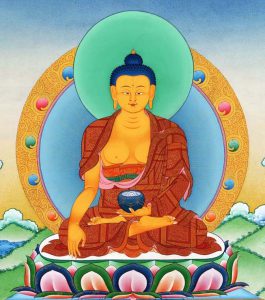
Buddhism is principally a method for bringing lasting peace and joy to our minds. Our inner mental anguish cannot be cleared simply by improving our external material situation. In the present age, material development is rapidly progressing, but it brings physical comfort and health alone, rather than helping to relieve our inner disquiet.
Seeing for ourselves how it is that many rich people enjoy wondrous standards of living, whilst at the same time remaining unhappy in their minds, shows us that external prosperity and money alone cannot bring the comfort and happiness we seek. Indeed, money is useless for healing the many sufferings we experience when our minds are in turmoil. Inner ease and joy must come from the way we think and use our minds.
For this reason, most of the religions in the world today try to bring peace and happiness to those encountering hardships. Among the different spiritual traditions, Buddhism, with its view of dependent origination and conduct of non-harm, is an abundant and sublime tradition.
The conduct of non-harm is rooted in limitless compassion, the wondrous attitude of someone who is brave enough to think about trying to dispel the suffering of every single living being. The physical and verbal conduct which stems from such an attitude is the conduct of non-harm. Physical and verbal conduct which stems from negative mental attitudes such as jealousy, greed, malice, resentment and anger is harmful conduct.
This practice of compassion itself is founded upon the view of dependent origination, which in this instance should be understood as the dependent relationship between cause and effect. Even the illustrious Buddha is not said to have been awakened by origin, independent of cause and effect. He too experienced many lives as an ordinary being, the same as ourselves, but was able to use cause and effect to his advantage, and gradually perfect the qualities of freedom and wisdom.
The outer container, our world, and it’s inner contents, sentient beings, also come into existence through cause and effect. It is important to recognise that the Buddha’s teaching form the only religion to hold the view of dependent origination.
Regarding the Buddha’s teachings, Our Teacher, the Buddha, first turned the Dharma-wheel of the four truths to all of his general disciples. Then, in response to those of pure karma, at Vulture Peak and other sites, he taught the sutras of the middle turning of the wheel of Dharma; chief among them, the Perfection of Wisdom sutras. Later, at Vaishali and other unspecified locations he taught the sutras comprising the final turning of the wheel of Dharma, such as those on Buddha Nature and The Sutra Unravelling the Intention. Thus he turned the wheel of Dharma three times.
Of these three, in the first turning, he taught mainly the dependent origination of cause and effect, and on that basis, the sixteen aspects of the four truths such as impermanence.
In the middle turning of the wheel of Dharma, he taught dependent origination of being dependently imputed, imputed existence based on the mere naming of a basis for designation, or the subtle dependent origination of mere conceptual imputation. This ascertains the nature of objects down to their most subtle levels.
In other words, the middle turning teaches how to come to a complete understanding of the emptiness of objects, and then the methods for gaining personal experience of it.
In the final turing of the wheel of Dharma there is a general presentation of the clear light as well as the teachings on Buddha-nature, our basic element. These teaching bridge the sutra and the mantra teachings. The mantra texts were taught for a small portion of those disciples with faultless karma.
In this way, the Buddha turned the wheel of Dharma of the greater and lesser vehicles, together with the mantra vehicle, for the sake of both ordinary and exceptional disciples. These teachings, in their entirety, have been upheld in the Dharma Lineage of the great Nalanda University.
Notably, with the coming of the glorious protector Nagarjuna, among others, the meaning of the teachings of the three turnings, were elucidated. This caused all the greater and lesser vehicle teachings, together with those of the mantra vehicle, to be upheld, protected and propagated.
Gradually they then spread to China, Sri Lanka and many other countries. After this, the teachings came to Tibet in earlier and later waves. There are various Dharma traditions in Tibet due to differences in the time and place in which the teachings arrived. These became known as the Nyingma Early Translation School, and the Sarma New Translation School. In the Sarma there are many Dharma lineages, such as the Kadampa, Kagyu, Shangpa, Sakya, Geluk and Jonang, all of which trace their source to Nalanda.
In brief, the Buddhadharma of the Snowland of Tibet, is that which came via Nalanda, and contains the entirety of the Buddha’s teaching—the greater, lesser and mantra vehicles.
